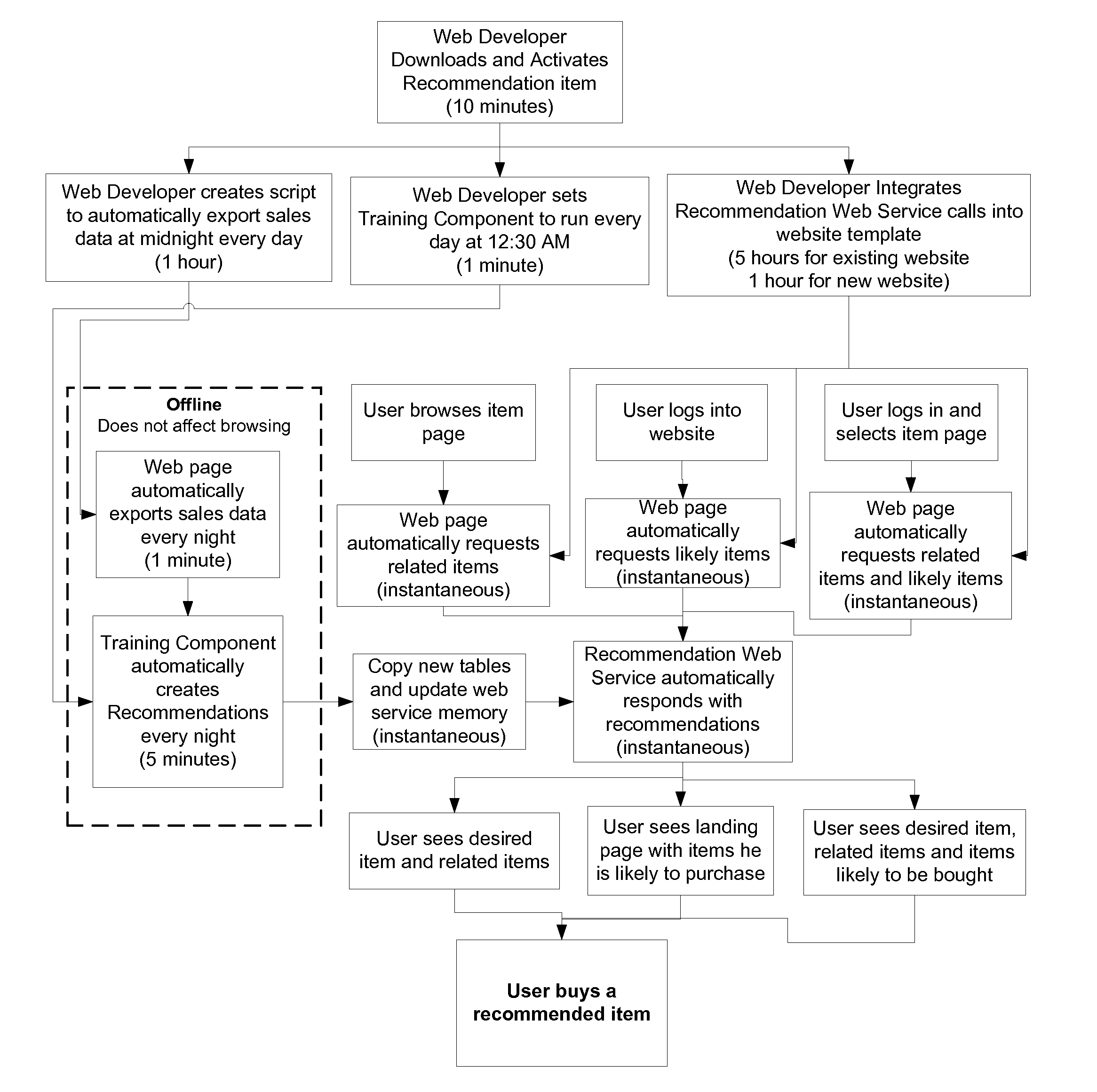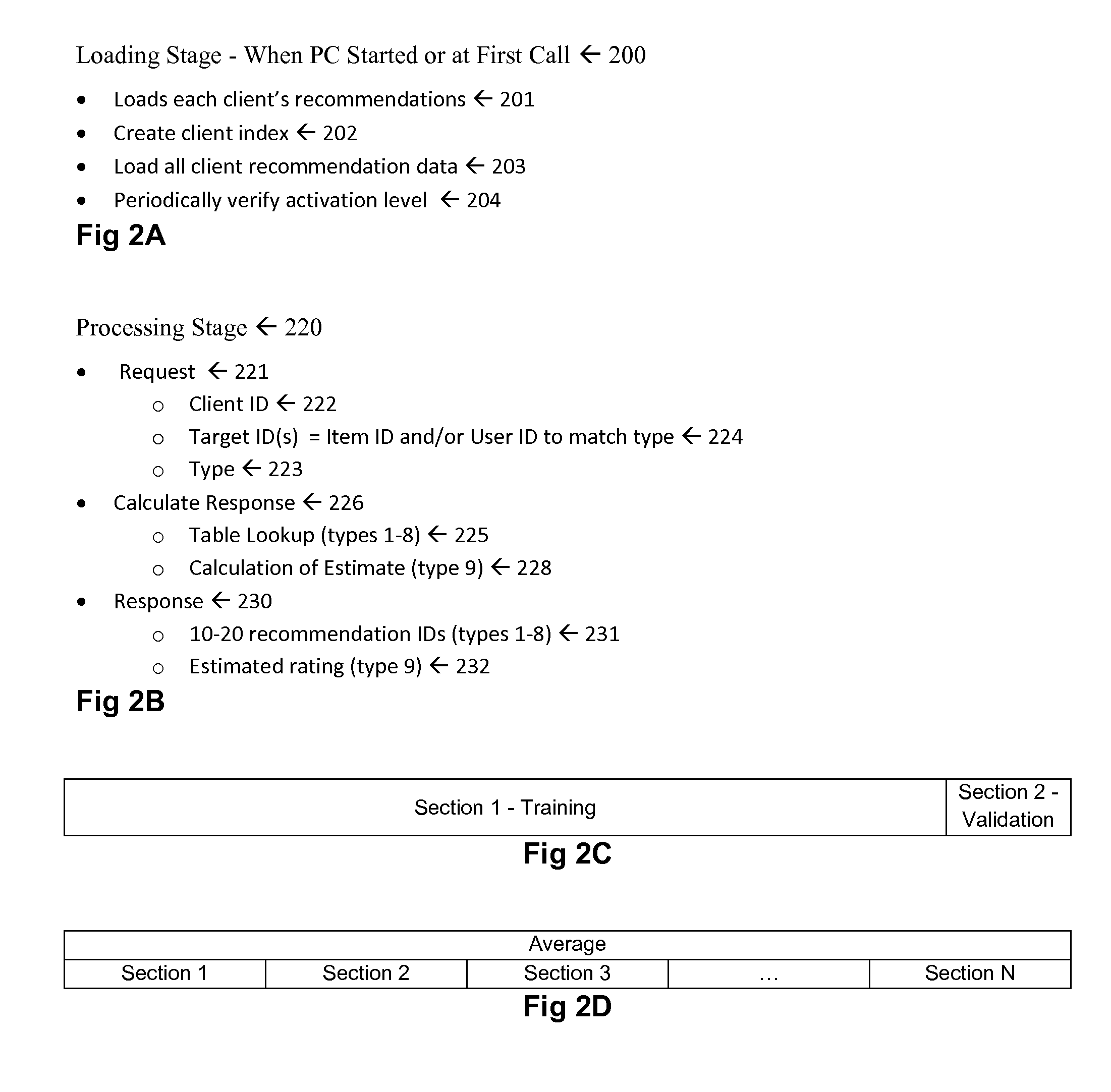[0017]One embodiment of this invention is a recommendation
system that works off-the-shelf by exporting historical action data or linking to the
client's website action
database, using novel or existing training algorithms, creating recommendation tables from the six basic recommendation types, and requesting information for the
client. The recommendation system can be a
computer program whose input is a configuration file that includes a
list of historical data files. Furthermore, the recommendation system easily connects to any website using a
web service that is called by the client's website that receives client, user and / or item IDs and returns recommendation IDs from the recommendation table. The recommendation
web service can run behind the same firewall as the client's website
database or be hosted elsewhere, such as on
the Internet in a physical or virtual
server (i.e. in the cloud).
[0019]The system can also connect to a user email system in several ways. First, the email
list contains only the likely users for an item so that users don't receive too many emails and
opt out. Second, the email inserts likely items for the recipient user at creation, possibly limited to a
list of a few, such as 20, likely items so it's easier to manage. Third, the email includes a dynamic link, which upon opening the email updates an email template to include images of likely items and links to likely item web pages, again possibly limited to a list of a few items so it's easier to manage.
[0020]In many real-world situations, the actions are not numeric (i.e. non-rated). This is also known as a nominal value in
measurement theory. (A rating is ordinal since a higher rating is better than a lower rating, but the difference between a 1 and 2, and a 2 and 3 are not defined.) The target item, user pair actions (meaning that an action includes a user and an item, in other words, a user acting on an item) in the historical data can be represented by a
numeric value in several fashions. In the simple
conversion method, one or more actions are represented as a 1, or inherently by saving the target item and user ID pair as an action (i.e. sale). For the repeat
conversion method, the count value for the target pair is the number of actions by the target user on the target item. For the scaled
conversion method, the number of actions are scaled by total actions, maximum actions, or logarithm, such that proportional relationship are converted to offset, where offset works best with most training
algorithm, especially those based upon Pearson. Finally, a sigmoid or related conversion method can be used. In this method, for a value of 1, the estimates for a user and item pair are interpreted in terms of likelihood of action, such as a purchase, rental, play, etc. Furthermore, the first action can be turned into a number near one, like 0.8, and additional actions increase the rating further towards 1—such as using a
sigmoid function. In this case, which is especially useful for items that a user re-uses, numerous actions increase the likelihood of future actions.
[0027]Finally, the system includes a control panel, which is used to control recommendation touts using a few parameters that control the response of the recommendation web service. The parameters determine if the web service should respond with best, similar, related, likely, promotion, or top selling items, and if the response should change if the likelihood and / or number of common users is below a minimum value. Importantly, this enables promotions to intelligently be included in recommendations, ordered with other top sellers as well as suggested with the proper category. The control panel also allows promotional items to be pre-weighted with artificial sales or artificial similarities with other items (such as a bikini top and bottom or windsurf sail and mast). Finally, the control panel can include a maximum price to limit recommendations' price (assuming that the price is included with the item ID).
[0028]Similar items are determined by several methods. In the first method, similar items are determined from top sellers in the same categories as the target item. In the preferred embodiment,
product type and brand are used as the category types. In the second method, similar items are determined from items that are related to the same item but not related to each other. In the preferred embodiment,
brute force is used where, for a target item, the system searches each related item to find subsequent related items (those related to the related items) that are not related to the target item. In another embodiment, grouping techniques use the similarities, such as using the inverse of the similarities as the distances, to determine clusters of items. The grouping techniques can be clustering, Kohonen self-organizing maps or gravity based clustering. The similarities are from any or all of the methods to determine related items. The cluster includes items with few users in common, which are similar items (such as two different belts that go with the same pants), and items with several users in common, which are related items (such as pants and a belt). In the third method, similar items are determined from items viewed by the same user (i.e. related items based upon views and not actions). The results from each method are optimally combined to increase the diversity of recommendations.
 Login to View More
Login to View More  Login to View More
Login to View More 


